- News
- Reviews
- Bikes
- Components
- Bar tape & grips
- Bottom brackets
- Brake & gear cables
- Brake & STI levers
- Brake pads & spares
- Brakes
- Cassettes & freewheels
- Chains
- Chainsets & chainrings
- Derailleurs - front
- Derailleurs - rear
- Forks
- Gear levers & shifters
- Groupsets
- Handlebars & extensions
- Headsets
- Hubs
- Inner tubes
- Pedals
- Quick releases & skewers
- Saddles
- Seatposts
- Stems
- Wheels
- Tyres
- Tubeless valves
- Accessories
- Accessories - misc
- Computer mounts
- Bags
- Bar ends
- Bike bags & cases
- Bottle cages
- Bottles
- Cameras
- Car racks
- Child seats
- Computers
- Glasses
- GPS units
- Helmets
- Lights - front
- Lights - rear
- Lights - sets
- Locks
- Mirrors
- Mudguards
- Racks
- Pumps & CO2 inflators
- Puncture kits
- Reflectives
- Smart watches
- Stands and racks
- Trailers
- Clothing
- Health, fitness and nutrition
- Tools and workshop
- Miscellaneous
- Buyers Guides
- Features
- Forum
- Recommends
- Podcast
TECH NEWS
Olympics Tech 2012: Ryder Hesjedal's Cervélo R5ca
There’s just the slightest of chances you’ll have heard that the Olympic men’s road race will be fought out this Saturday (28 July), and Giro d’Italia winner Ryder Hesjedal will be racing it on this maple leafed up Cervélo R5ca.
Hesjedal was forced to withdraw from the Tour de France after damaging his hip and leg in a crash on stage six but he says he has recovered and will be racing in London and Surrey.

Hesjedal rides for Garmin-Sharp although the Olympics is contested as national teams rather than ProTour teams. He’ll still be riding a bike from Garmin-Sharp sponsor Cervélo but rather than the usual livery, this one has been designed with maple leaves aplenty from the national flag of Canada. Both Hesjedal and Cervélo are Canadian.
The R5ca is Cervélo’s top-level lightweight road bike. It comes with Cervélo’s second generation Squoval tubing – Squoval coming from the words square and oval, to save you working it out for yourself. That’s because the tubes are square with rounded corners, the idea being, in Cervélo’s own words:
• Squared tubes have more material far from the centre to reduce side-to-side flex.
• Convex walls and rounded corners improve torsional stiffness.
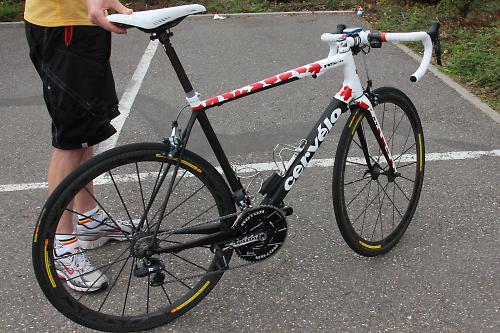
Check out the skinniness of the seatstays. They’re among the thinnest out there in order to absorb vibration and add comfort.
The ‘ca’ bit of the R5ca name denotes that this is a Project California model. The Cervélo engineers have taken a standard R5 and altered the carbon layup and the tube profiles slightly to drop the weight a touch while retaining the stiffness. They reckon a size 54cm comes in at around 680g – incredibly light. These bikes are handbuilt in California.
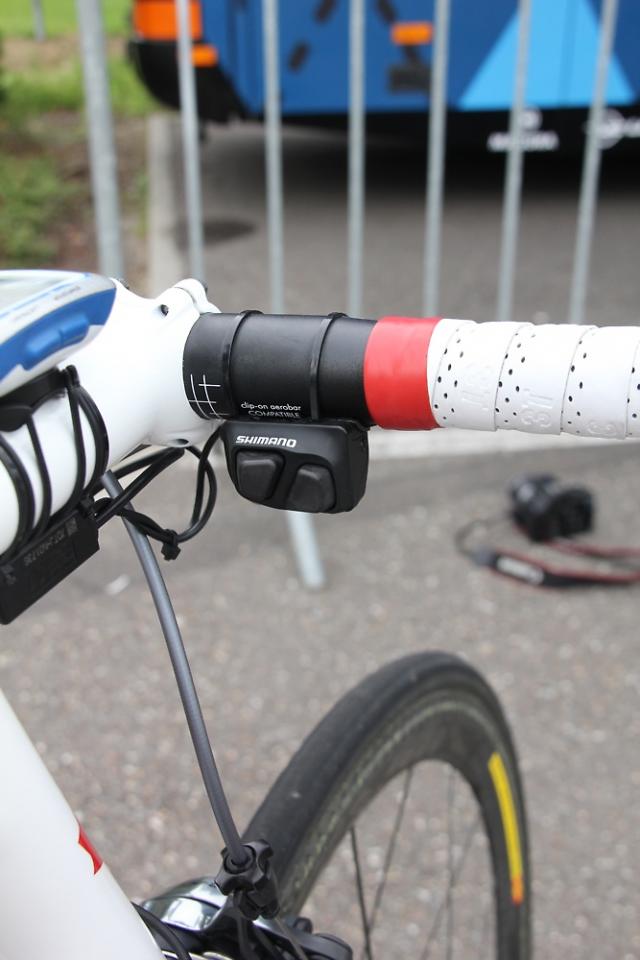
Hesjedal uses an electronic Shimano Dura-Ace Di2 groupset and you can see that he has a satellite shifter on the tops so he can change gear when climbing without the need to move his hands back onto the hoods or the drops.
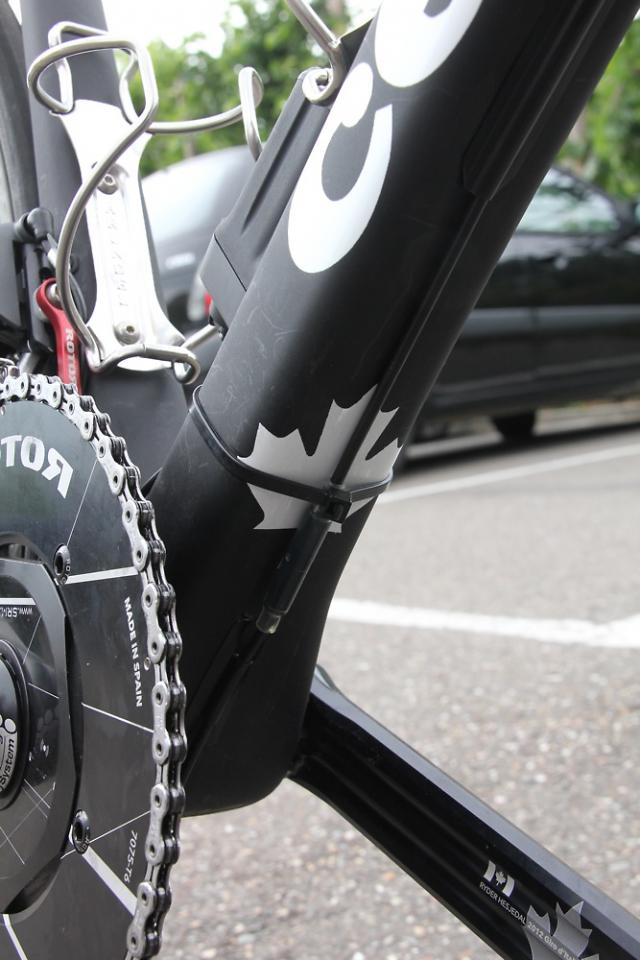
You can also see that the Di2 cable runs externally underneath the down tube; the R5ca doesn’t have internal routing. The cable stops on the down tube are redundant.
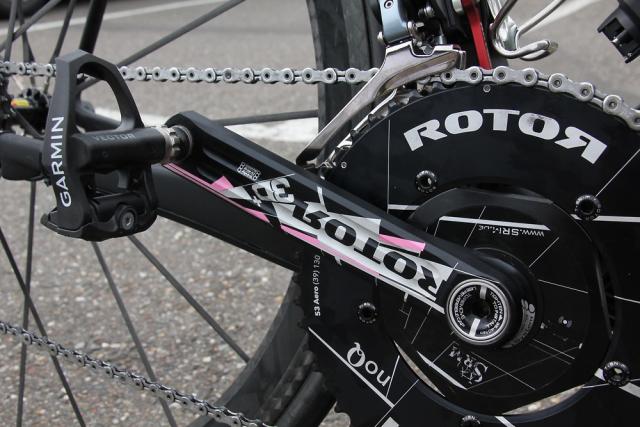
Garmin-Barracuda use Rotor cranks, Hesjedal going with 3D+ and an SRM power measurement system. Those pink highlights are a neat touch to mark his Giro win earlier in the year and, just in case you were in any doubt, Rotor have added ‘Ryder Hesjedal 2012 Giro d’Italia winner’ to the inside of the crank.
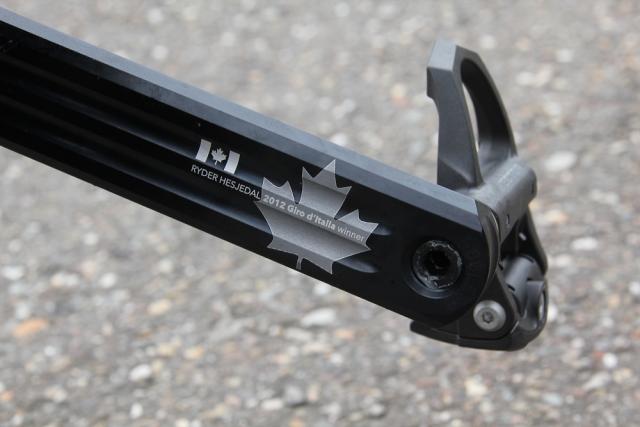
One other thing that’s worth noting is that front end. Hesjedal is 1.88m (6ft 2in) tall but he’s on a 56cm bike with a 140mm stem. Most pros run a lengthy stem, allowing them to get the stretched position they want on as small and light a bike as possible.

And check out the seal on top of the headset… or, rather, the lack of one. There’s nothing between the upper cartridge bearing and the stem, allowing the mechanics to position the 3T Ergosum Pro alloy bars a little lower on that already downward-sloping stem. That does leave the headset far more open to the elements but it’s very, very unlikely to rain in the UK summer anyway. Ahem!
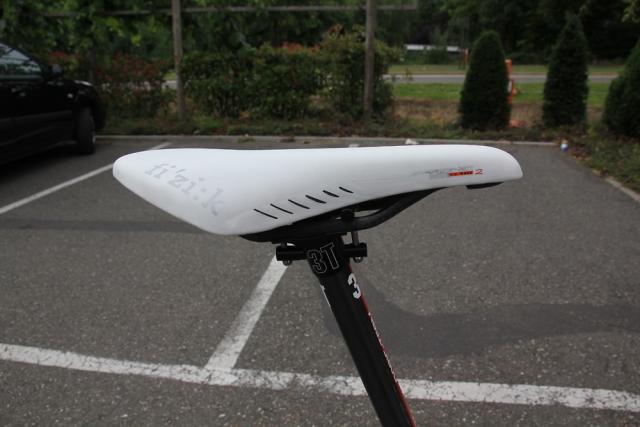
The wheels are Mavic Cosmic Carbone, the post is a carbon-fibre 3T Doric Team and the saddle ia a Fizik Arione Tri2 with carbon braided rails. Those are Stainless Cages from Arundel.
Mat has been in cycling media since 1996, on titles including BikeRadar, Total Bike, Total Mountain Bike, What Mountain Bike and Mountain Biking UK, and he has been editor of 220 Triathlon and Cycling Plus. Mat has been road.cc technical editor for over a decade, testing bikes, fettling the latest kit, and trying out the most up-to-the-minute clothing. He has won his category in Ironman UK 70.3 and finished on the podium in both marathons he has run. Mat is a Cambridge graduate who did a post-grad in magazine journalism, and he is a winner of the Cycling Media Award for Specialist Online Writer. Now over 50, he's riding road and gravel bikes most days for fun and fitness rather than training for competitions.
Latest Comments
- BikingBud 1 sec ago
And relevant to the reminiscence of the mini, here we see the reality of the fashion driven size increase in the classic small car.
- mark1a 1 min 44 sec ago
This simply isn't true. I've been running radar lights for 10 years now. I cycle mostly on rural roads, I get notified of approaching vehicles up...
- Rendel Harris 2 hours 31 min ago
Genuinely puzzled as to how you've extrapolated that from what I said. Care to explain?
- Pub bike 4 hours 42 min ago
He is up against the global trading system, which has obviously been in the news a lot lately. Framebuilders in other countries can undercut him,...
- David9694 6 hours 15 min ago
Stouport residents bemoan huge traffic queues through town...
- rookybiker 17 hours 8 min ago
The trailer seems to connect to both ends of the rear axle. Can it do tight corners without dragging the tyre sideways?
- Destroyer666 18 hours 5 min ago
Have you owned Bont shoes? In my experience even the widest Lake shoes have had a bizarre form of narrowing way too much in the toe area. But the...
- froze 18 hours 33 min ago
Not sure if this is possible, but this news letter goes out all over the world, and some places like Decathlon does not send stuff to America, in...




















Add new comment
19 comments
I hope the brand logos, 'Cervelo' and 'Rotor' aren't too prominent for the IOC.
i would have thought they would have put carbon bottle cages on his bike. would think they have the budget to get some
would think they have the budget to get some
I think the Arundel steel cages work better, and are probably more aerodynamic than carbon fibre when empty.
I was thinking that they're getting power measurement from both sources to allow Garmin to validate the data and minimse the margin for error. Just part of the test process.
Anyone else confiused by the SRM meter AND the Vector pedals?
I suspect the pedals are dummy units, based on their long gestation period...
Vector pedals need a sensor to measure power. This fits onto the pedal axle, next to the crank.
As you can see, this isn't present so the pedals are not measuring power, hence the SRM unit.
Had a look at one in my LBS earlier, stoopidly light.
I think what happens with stem length is that the pros like a fork with sort rake and/or a steep head tube angle for snappy handling, but that makes the bike unstable, so they prefer a long stem which neutralises the snappy handling and makes it normal again. ie: I think it is just fashion.
Or, to be more charitable, maybe they prefer to get their weight further over the front wheel, which makes the bike feel better in corners?
Oh, by the way, here's the full story on the name from Slipstream Sports who own the team:
"The official UCI-registered name of the team will be Garmin-Sharp (GRS), just in time for start of 2012 Tour de France. Barracuda Networks will continue as an important co-title sponsor, and team materials and the website will refer to the team as Garmin-Sharp-Barracuda."
That's an insane amount of Hbar drop, must be like 20cm!
Just my luck, I'll be doing what Brad says he will be doing twenty years from now, marshalling on a roundabout as the road race is in full swing.
I always thought a *shorter* stem made steering response snappier? Now I'm hearing the opposite? How does having to move the handlebars in a wider arc to accomplish the same degree of turning equate to "quicker" steering?
At any rate, I hope Ryder is recovered. Racing is usually the best training for more racing, but coming off a huge effort in the Giro, I wonder if the time off from the latter part of the TdF wasn't actually a good thing for him.
I *think* it's because you're effectively reducing the fork rake, so it could be related to where your weight is...? Or perhaps you're effectively giving yourself a longer lever with which to rotate the forks. Physics = not my strongest suit. I just know I put a 120mm stem on a small bike such that the clamp was almost directly over the front hub and it became almost unrideably twitchy.
Yes, that's obviously correct. That's what happens when you get halfway through a sentence and then decide to express it another way. Sorry for the confusion.
Ah well god knows what happened to mine then. There's some scale of twitchiness just out of my comprehension that has unicycles at one end and beach cruisers at the other, but I'm obviously out of my depth now...
It's quite alright. I find this stuff fascinating and a bit confusing at times anyway... there are so many weird little things the pros do that don't make any sense at all for a recreational rider. If I set up my bike like Ryder's and tried to ride it 100 miles, I'd either end up in a full body cast drinking my meals through a straw, or at best, my back would be so twisted up I'd never be able to stand up straight again. Oh yeah, and I'd be flat broke.
"Garmin-Barracuda"? I think there will be a certain electronics manufacturer who might take offense...
That's the downside of changing your name mid-season as Garmin Cervelo Sharp Chippotle are constantly doing. Without cheching I'm not even sure if they Sharp deal was for one race or if it carries on until the end of the season - as Garmin have done with name changes in the past.